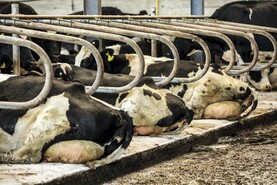Grass quality was very poor here on the last few paddocks grazed, and it has affected the milk tank big time.
In my opinion, the protected urea has caused the main problem. The last paddocks I spread with protected urea from the 10 to 13 June are where it didn’t work, before that it seemed to be working fine.
The real confirmation for me was a paddock I spread on the 14 June with CAN. It was grazed with a cover of 1,600kg DM/ha one week before the paddocks spread with protected urea.
But the grass was also a much healthier green, the protected urea paddocks were very pale and yellow, like they had received no nitrogen. The milk results also provide more evidence.
On the CAN paddock, milk urea was 18 and yield was 24 litres, while on the protected urea paddocks milk urea dropped to 11 and yield dropped to 21 litres.
When I think back to the last few summers, I didn’t have this problem. In those years I had a lot of fertiliser bought early in the year, so I didn’t buy protected urea as it would not have been used before the protection wore off.
I have heard a lot of farmers talking about having the same problems with protected urea but they are not being listened to, or are told it’s not the protected urea, it is other factors.
For me, the evidence on our farm clearly shows the protected urea is the difference. I am all for sustainability and using products like protected urea, if they work.
If it completely fails in certain weather, which it appears to have done with me, farmers should be made aware of this. That kind of loss in milk production is not acceptable, and if I had not been advised to change to CAN, I would be in a worse position.
The next paddocks for grazing are looking very green, so hopefully the yield will recover. Thankfully the protein held between 3.71% and 3.74%.
Second cut
The second cut is due to be cut now if we can get a few fine days. Some fields of this are not great either with yellow, hungry looking patches.
This also got protected urea, so I am afraid this could have been affected too. Putting all my faith in protected urea might not have been the best decision.
Dad made a start at harvesting the winter barley, but had to stop because of rain. He got the straw of what he cut baled without rain, so he is happy with that.
Hopefully he can get it finished off this week and then we can put the silage sides back onto the trailers and get the second cut in the pit.
Our cows were weighed last week through ICBF. We never had the herd weighed before, and I felt it was no harm to know their actual weight rather than guessing. The first to third lactation cows averaged 530kg and from fourth lactation on averaged 640kg.
ICBF also has a new profile feature showing kilograms of milk solids relative to liveweight, which shows our cows are predicted to do 0.9kg MS/kg liveweight this year.
I would rather this was higher, and I would be confident that if we had a normal year of consistent grass growth we would achieve 1kg MS/kg liveweight.
We got some of the sheds painted over the last two weeks. We hired out a cherry picker for a week to get it done safely. We got them all power washed in two days and got the primer on the following day.
Then we had to wait four days on the weather to get back to it, to put on the grey. A great local man Paul Kavanagh looked after the spraying and I worked the cherry picker.






 This is a subscriber-only article
This is a subscriber-only article










SHARING OPTIONS: